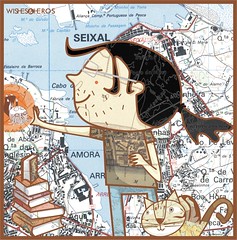A brief history of Freemasonry in the Iberian Peninsula
Spain and Portugal are doubtless the two European countries whose history of Freemasonry was the most dramatic and the periods of anti-Masonic repression the most brutal. The omnipresence of the Roman Catholic Church, fierce adversary of Free Masonry and its tolerance in religious matters until the end of the twentieth century, and its broad implication in political affairs in these countries, was certainly instrumental.
The first Spanish Lodge was founded in 1728 in Madrid, by the Duke of Wharton, past Grand-Master of the Grand Lodge of London, exiled because of his loyalty to the Stuart cause. It was highly successful but the persecutions started as of 1740, when King Phillip V decided to obey the bull of Pope Clement XII. Masons were banished, imprisoned, condemned to the galleys. Freemasonry continued to evolve, however, among the English and French living in Spain. The situation worsened again in 1751 when King Ferdinand VI authorised the Inquisition to persecute the Brethren. Conditions returned to normal under the reign of Charles III and in 1780 the "Grand Orient of Spain" was founded, whose first Grand-Master was a Minister, the Count of Aranda.
There were only two Lodges in Portugal at the time of the excommunication pronounced in 1738 by Clement XII. One had mostly English and French members, the other Irish Catholics. The second was thus immediately to become the target of the Inquisition and had to cease all activities, while the first was able to discreetly continue its work for five years before its Worshipful Master, a Frenchman, was arrested together with several of his Brethren, tortured and sent to the galleys. The situation improved temporarily under the liberal reign of Joseph II (1750-1777) before worsening again.
During the Napoleonic Empire, Spain as well as Portugal saw numerous English and French soldiers confront each other on their soil. As far as the French were concerned, it must be kept in mind that some fought in Napoleon’s armies, while many others had rallied the English cause. Masons were numerous on both sides, and this period was therefore rather favourable to Freemasonry. In particular, the Frenchman de Grasse-Tilly founded the "Supreme Counsel of the Ancient and Accepted Scottish Rite " of Spain in 1811. At that same time, Portugal numbered 13 Lodges, often founded in the wake of the Freemason generals Junot, Soult and Wellington.
After the fall of the Empire, renewed periods alternately of persecution and calm succeed each other, depending on the political fortunes of the period. We must note here that the fact that Freemasons were numerous in the Napoleonic and English armies as well as among the revolutionaries who obtained the independence of the Spanish colonies in South America (Bolivar, San-Martin and Mosquera, among others, were Freemasons) was probably not beneficial to the image of Freemasonry in Spain, to say the least. Under the dictatorship of Dom Miguel, more than 600 Brethren would be murdered in Lisbon. In Spain, many Freemasons were decapitated, hanged or garrotted.
In Portugal it was not until 1833, with the return of Queen Maria II, and 1868 in Spain at the fall of Queen Isabella, that the situation improved somewhat, in spite of still frequent vicissitudes causing often confusing conditions. There were however not more than some 6000 Freemasons in Spain until the 1930s.
As in many other Continental European countries, the twentieth century was also to be grim for Freemasonry in the Iberian Peninsula, since from the 1930s onward the regimes of the dictators Salazar et Franco would again totally proscribe Freemasonry, to which they reproached principally its tolerance towards Protestantism, its English origin and its liberal ideas. Particularly in Spain, the Freemasons who fell into the hands of Franco’s troops during the civil war were systematically executed. It seems that after the civil war certain others were "sold" by Franco to the United States to avoid being put to death.
Since the return of democracy in the two countries in the 1970s, Freemasonry was progressively revived. It is worthy of note that after three centuries of hostility, the Catholic Church seems no longer to be opposed to it in the Iberian Peninsula, in as much as its " Cannon Law " no longer explicitly excommunicates Freemasons, its influences in civil society is diminished and some of its standpoints have evolved considerably in the period of the Vatican II Council.
The first Spanish Lodge was founded in 1728 in Madrid, by the Duke of Wharton, past Grand-Master of the Grand Lodge of London, exiled because of his loyalty to the Stuart cause. It was highly successful but the persecutions started as of 1740, when King Phillip V decided to obey the bull of Pope Clement XII. Masons were banished, imprisoned, condemned to the galleys. Freemasonry continued to evolve, however, among the English and French living in Spain. The situation worsened again in 1751 when King Ferdinand VI authorised the Inquisition to persecute the Brethren. Conditions returned to normal under the reign of Charles III and in 1780 the "Grand Orient of Spain" was founded, whose first Grand-Master was a Minister, the Count of Aranda.
There were only two Lodges in Portugal at the time of the excommunication pronounced in 1738 by Clement XII. One had mostly English and French members, the other Irish Catholics. The second was thus immediately to become the target of the Inquisition and had to cease all activities, while the first was able to discreetly continue its work for five years before its Worshipful Master, a Frenchman, was arrested together with several of his Brethren, tortured and sent to the galleys. The situation improved temporarily under the liberal reign of Joseph II (1750-1777) before worsening again.
During the Napoleonic Empire, Spain as well as Portugal saw numerous English and French soldiers confront each other on their soil. As far as the French were concerned, it must be kept in mind that some fought in Napoleon’s armies, while many others had rallied the English cause. Masons were numerous on both sides, and this period was therefore rather favourable to Freemasonry. In particular, the Frenchman de Grasse-Tilly founded the "Supreme Counsel of the Ancient and Accepted Scottish Rite " of Spain in 1811. At that same time, Portugal numbered 13 Lodges, often founded in the wake of the Freemason generals Junot, Soult and Wellington.
After the fall of the Empire, renewed periods alternately of persecution and calm succeed each other, depending on the political fortunes of the period. We must note here that the fact that Freemasons were numerous in the Napoleonic and English armies as well as among the revolutionaries who obtained the independence of the Spanish colonies in South America (Bolivar, San-Martin and Mosquera, among others, were Freemasons) was probably not beneficial to the image of Freemasonry in Spain, to say the least. Under the dictatorship of Dom Miguel, more than 600 Brethren would be murdered in Lisbon. In Spain, many Freemasons were decapitated, hanged or garrotted.
In Portugal it was not until 1833, with the return of Queen Maria II, and 1868 in Spain at the fall of Queen Isabella, that the situation improved somewhat, in spite of still frequent vicissitudes causing often confusing conditions. There were however not more than some 6000 Freemasons in Spain until the 1930s.
As in many other Continental European countries, the twentieth century was also to be grim for Freemasonry in the Iberian Peninsula, since from the 1930s onward the regimes of the dictators Salazar et Franco would again totally proscribe Freemasonry, to which they reproached principally its tolerance towards Protestantism, its English origin and its liberal ideas. Particularly in Spain, the Freemasons who fell into the hands of Franco’s troops during the civil war were systematically executed. It seems that after the civil war certain others were "sold" by Franco to the United States to avoid being put to death.
Since the return of democracy in the two countries in the 1970s, Freemasonry was progressively revived. It is worthy of note that after three centuries of hostility, the Catholic Church seems no longer to be opposed to it in the Iberian Peninsula, in as much as its " Cannon Law " no longer explicitly excommunicates Freemasons, its influences in civil society is diminished and some of its standpoints have evolved considerably in the period of the Vatican II Council.




